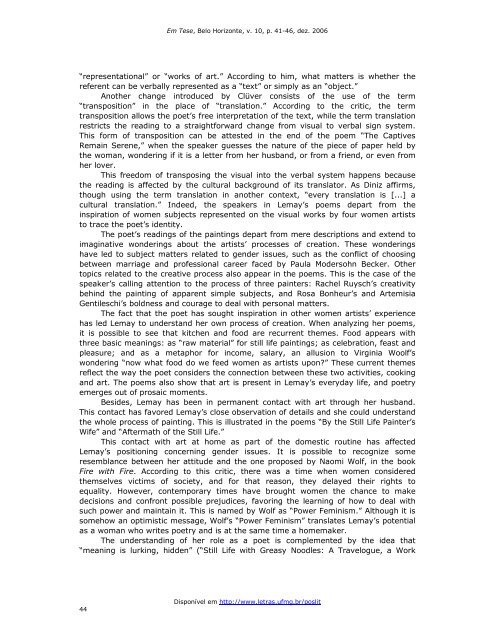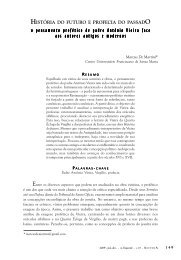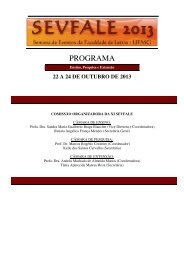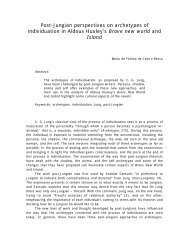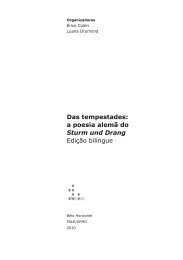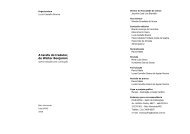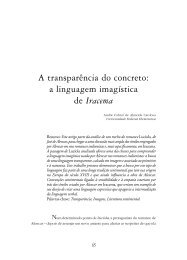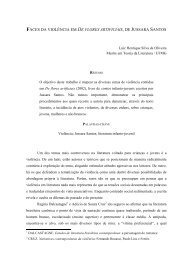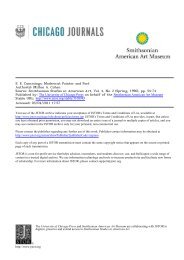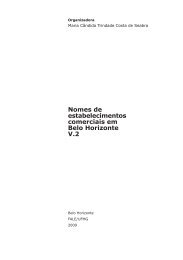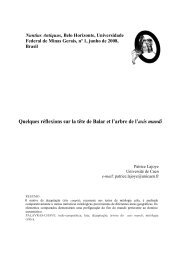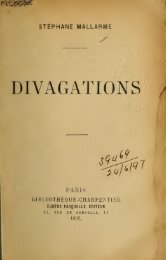Contornos do Indizível: o estilo de Clarice Lispector - Fale - UFMG
Contornos do Indizível: o estilo de Clarice Lispector - Fale - UFMG
Contornos do Indizível: o estilo de Clarice Lispector - Fale - UFMG
Create successful ePaper yourself
Turn your PDF publications into a flip-book with our unique Google optimized e-Paper software.
Em Tese, Belo Horizonte, v. 10, p. 41-46, <strong>de</strong>z. 2006<br />
“representational” or “works of art.” According to him, what matters is whether the<br />
referent can be verbally represented as a “text” or simply as an “object.”<br />
Another change introduced by Clüver consists of the use of the term<br />
“transposition” in the place of “translation.” According to the critic, the term<br />
transposition allows the poet’s free interpretation of the text, while the term translation<br />
restricts the reading to a straightforward change from visual to verbal sign system.<br />
This form of transposition can be attested in the end of the poem “The Captives<br />
Remain Serene,” when the speaker guesses the nature of the piece of paper held by<br />
the woman, won<strong>de</strong>ring if it is a letter from her husband, or from a friend, or even from<br />
her lover.<br />
This free<strong>do</strong>m of transposing the visual into the verbal system happens because<br />
the reading is affected by the cultural background of its translator. As Diniz affirms,<br />
though using the term translation in another context, “every translation is [...] a<br />
cultural translation.” In<strong>de</strong>ed, the speakers in Lemay’s poems <strong>de</strong>part from the<br />
inspiration of women subjects represented on the visual works by four women artists<br />
to trace the poet’s i<strong>de</strong>ntity.<br />
The poet’s readings of the paintings <strong>de</strong>part from mere <strong>de</strong>scriptions and extend to<br />
imaginative won<strong>de</strong>rings about the artists’ processes of creation. These won<strong>de</strong>rings<br />
have led to subject matters related to gen<strong>de</strong>r issues, such as the conflict of choosing<br />
between marriage and professional career faced by Paula Mo<strong>de</strong>rsohn Becker. Other<br />
topics related to the creative process also appear in the poems. This is the case of the<br />
speaker’s calling attention to the process of three painters: Rachel Ruysch’s creativity<br />
behind the painting of apparent simple subjects, and Rosa Bonheur’s and Artemisia<br />
Gentileschi’s boldness and courage to <strong>de</strong>al with personal matters.<br />
The fact that the poet has sought inspiration in other women artists’ experience<br />
has led Lemay to un<strong>de</strong>rstand her own process of creation. When analyzing her poems,<br />
it is possible to see that kitchen and food are recurrent themes. Food appears with<br />
three basic meanings: as “raw material” for still life paintings; as celebration, feast and<br />
pleasure; and as a metaphor for income, salary, an allusion to Virginia Woolf’s<br />
won<strong>de</strong>ring “now what food <strong>do</strong> we feed women as artists upon?” These current themes<br />
reflect the way the poet consi<strong>de</strong>rs the connection between these two activities, cooking<br />
and art. The poems also show that art is present in Lemay’s everyday life, and poetry<br />
emerges out of prosaic moments.<br />
Besi<strong>de</strong>s, Lemay has been in permanent contact with art through her husband.<br />
This contact has favored Lemay’s close observation of <strong>de</strong>tails and she could un<strong>de</strong>rstand<br />
the whole process of painting. This is illustrated in the poems “By the Still Life Painter’s<br />
Wife” and “Aftermath of the Still Life.”<br />
This contact with art at home as part of the <strong>do</strong>mestic routine has affected<br />
Lemay’s positioning concerning gen<strong>de</strong>r issues. It is possible to recognize some<br />
resemblance between her attitu<strong>de</strong> and the one proposed by Naomi Wolf, in the book<br />
Fire with Fire. According to this critic, there was a time when women consi<strong>de</strong>red<br />
themselves victims of society, and for that reason, they <strong>de</strong>layed their rights to<br />
equality. However, contemporary times have brought women the chance to make<br />
<strong>de</strong>cisions and confront possible prejudices, favoring the learning of how to <strong>de</strong>al with<br />
such power and maintain it. This is named by Wolf as “Power Feminism.” Although it is<br />
somehow an optimistic message, Wolf’s “Power Feminism” translates Lemay’s potential<br />
as a woman who writes poetry and is at the same time a homemaker.<br />
The un<strong>de</strong>rstanding of her role as a poet is complemented by the i<strong>de</strong>a that<br />
“meaning is lurking, hid<strong>de</strong>n” (“Still Life with Greasy Noodles: A Travelogue, a Work<br />
44<br />
Disponível em http://www.letras.ufmg.br/poslit


